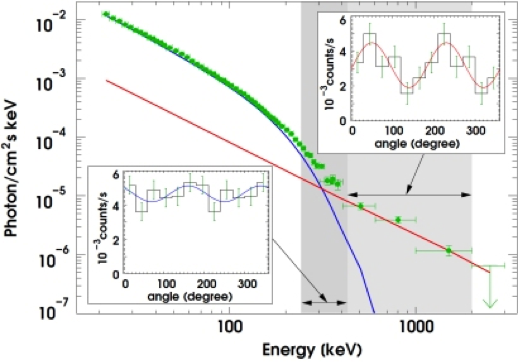MeV emission of black hole binaries
Both inflows and outflows in accreting black-hole binaries can produce continuum MeV emission. Relativistic electrons appear to be present in accretion flows in both hard and soft spectral states. MeV tails due to their Compton emission have been discovered in Cygnus X-1 and a number of other sources. Jets of those systems are known to contain relativistic electrons and can produce MeV emission via both synchrotron and Compton processes. Future observations in the MeV range will allow us to understand both the jets and accretion flows in those systems.
Required instrument performances:
For this topic, we concentrate on understanding of known sources. Thus, we need high sensitivity more than a wide field of view. Angular resolution of 0.1° is important to distinguish contributions of various sources. A sensitivity of 10-3 keV cm-2 s-1 is needed to measure spectral contributions from accretion and jets, and to distinguish between them. Confirmation of the polarization of Cygnus X-1 at about 1 MeV is crucial to determine whether the jet indeed contributes in that range.
 INTEGRAL/IBIS spectrum of Cygnus X-1 showing two components: a “Comptonization” spectrum between 20 and 400 keV (blue curve) and a power-law at higher energies (red curve). The two insets show measurements of the polarization signal between 250 and 400 keV (bottom left) and between 400 and 2000 keV (top right). In the first band, the measured signal is consistent with a flat signal. Credit: P. Laurent et al. |
Required instrument performances:
For this topic, we concentrate on understanding of known sources. Thus, we need high sensitivity more than a wide field of view. Angular resolution of 0.1° is important to distinguish contributions of various sources. A sensitivity of 10-3 keV cm-2 s-1 is needed to measure spectral contributions from accretion and jets, and to distinguish between them. Confirmation of the polarization of Cygnus X-1 at about 1 MeV is crucial to determine whether the jet indeed contributes in that range.
| Performance parameter | Goal value | Remarks and notes |
|
Field-of-view (FWHM, deg) |
A narrow field of view and high sensitivity | Detailed studies of individual sources |
|
Angular resolution (FWHM, deg) |
~ 0.1 | To mitigate possible source confusion. |
|
Spectral resolution (ΔE/E @ Energy) |
Not important for continuum studies | |
|
Line sensitivity (@ Energy) (cm-2 s-1, 3σ, 1 Ms) |
||
|
Continuum sensitivity (in which energy band?) (cm-2 s-1 keV-1, ΔE=E, 3σ, 1 Ms) |
EF(E) sensitivity of 10-3 keV/(cm2 s) |
To accurately measure the accretion and jet contributions in several black-hole binaries |
| Timing performances |
0.1 s at 1 MeV |
To distinguish between the jet and accretion origin of MeV emission |
|
Polarimetric capability (Minimum Polarization Fraction for a Crab source in 1 Ms) |
10% at 1 MeV |
To distinguish between the jet and accretion origin of MeV emission |
| Real-time data? |
 AstroMeV
AstroMeV